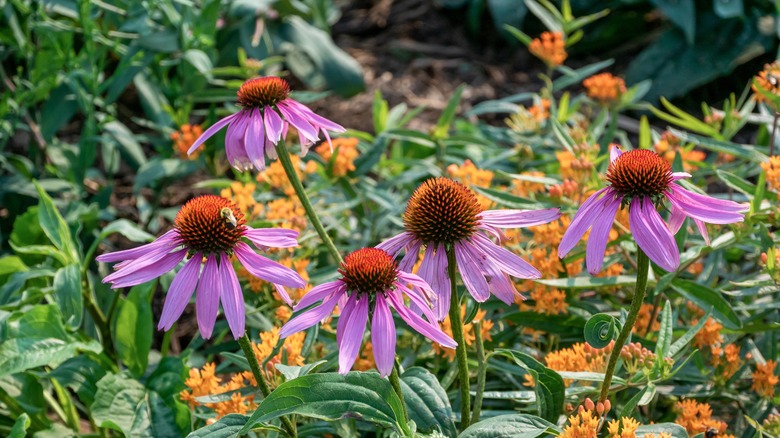Why Choosing Between Native And Non-Native Plants Is More Complicated Than You Think
For years, environmental conservationists have waxed poetic about the benefits of landscaping with native vegetation. Native plants attract birds to your yard, are easy to care for, are not invasive, and naturally foster biodiversity. While it's undeniable that native vegetation has its perks — just ask a monarch butterfly — deep down, all these green benefits hide their fair share of grays, half-truths, and innocent lies. Native plants aren't the end-all, know-all ecological solution that they're touted to be, and that's because it's hard to get a grip on what truly makes a native plant... native.
Despite several attempts (and definitions), the nativity hypothesis remains an enigma, meaning there's no foolproof method to define when a plant turns native. Ideally, that shouldn't be a problem if you aren't too hung up over the technicalities, but then all discussions on their planting advantages are undercooked, if not ill-informed. Moreover, nativity doesn't equal adaptation and survival. For instance, the Joshua tree, a Californian native, can barely survive there because of unfavorable conditions. So, it's worthwhile to learn whether your chosen native plant can actually survive in your garden and yield the benefits it's supposed to have.
What makes plants native
Plants are called native when they naturally occur in a location without human involvement, which defaults to all plants from the pre-European colonization era. However, this ignores the role played by the indigenous people who heavily transplanted and traded seeds and plant material across tribes, further muddying the definition of nativity. Besides, there are other natural ways to propagate plants, as happened in the case of the Mojave Desert's distinct Creosote Bush plantation, whose seeds were brought in by birds (rather than humans) from South America. Yet, the plant is tagged as native.
Not to mention, climate variables have always been influential — then and now. The ecosystem is in constant flux, adding and removing species as time passes, and plants aren't an exception. In fact, with the climate turning warmer, several plants are spilling over to higher latitudes and redefining their cultivation ranges, making plenty of people question if they aren't simply returning to their previous nativity ranges. Counterintuitively, mountain plants are shifting downhill in California to benefit from better rains, further blurring the lines. So, the matter of native plants being a natural, perfect fit for a place is up in the air.
Check for suitability
The issue at hand is that even if a plant is considered native, it still might not survive in its place of origin and may perform even worse in your yard. For example, aspens grow well on the mountainside, but their survival chances aren't any better than equally adaptive non-native plants when grown in your garden. A key reason for the native plants' poor site adaptation is the sheer difference in soil conditions. They aren't used to growing in poorly irrigated, aerated, compacted, and chemically treated soils, in addition to dealing with air pollution and the urban island heat effect. So, being native affords no special survival benefits unless the plant is naturally adaptive. But an adaptive native plant can also be weedy, especially if it grows aggressively like oaks. The USDA's Class C Noxious Weeds class includes quite a few native plants, too.
What's significant here, then, is that while there are plenty of solid reasons for the ingrained argument behind the importance of native plant restoration and biodiversity, a simplistic argument of "plant native plants only" isn't supported by the difficulty of defining what's still "native" in an ever-shifting landscape. For instance, yes, native plants are more resilient to native pests, but the very-real presence of exotic pests like Japanese beetles and chestnut blight is a whole new ball game. So, while riding the native plantation drive is admirable, and it's absolutely worth considering a plant's origin before you put it in the ground, the actual logic regarding whether it should or shouldn't go in your garden is more complex than many assume.


